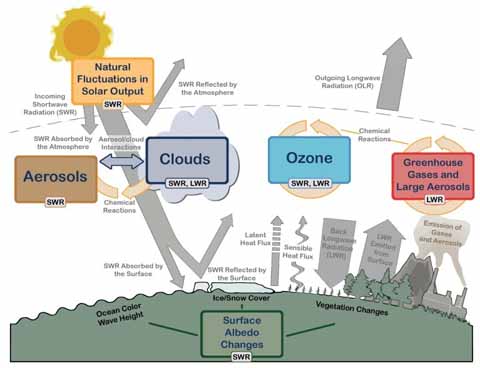Home → Sustainability → Climate → Climate Explored
Climate Explored
What determines the state of Earth’s climate?
Climate is determined by the balance between incoming and outgoing solar radiation achieved by the interaction between the atmosphere, ocean, biosphere, and other influential systems:
- amount of solar energy reaching earth
- chemical composition of the atmosphere and abundance of greenhouse gases
- volcanic activity and feedbacks associated with aerosols in the lower stratosphere
- ocean and atmosphere variability (e.g., El Niño Southern Oscillation [ENSO], North Atlantic Oscillation [NAO], and ocean meridional overturning circulation)
- biogeochemical cycles (e.g. carbon, hydrogen, oxygen, nitrogen)
- surface feedbacks from changes in snow cover and sea-ice extent
- variations in earth orbital geometry (obliquity [axial tilt], precession of the equinoxes, and eccentricity [shape of orbit] operating over very long timescales ranging 19K-100K years).

Climate Change 2013: The Physical Science Basis. Figure 1.1 | Main drivers of climate change. Intergovernmental Panel on Climate Change, Assessment Reports (1-6)
To learn more about reducing greenhouse gas emissions continue reading in Mitigation Actions.
To learn more about the changing climate, and its impacts and effects continue reading in Climate Trends & Data.
To learn more about adjustments to prepare for and adapt to impacts and effects continue reading in the Maine Adaptation Toolkit and in Adaptation Actions.
References and Further Resources:
Intergovernmental Panel on Climate Change
National Aeronautics and Space Administration
National Oceanic and Atmospheric Administration
- Climate.gov
- Teaching Climate
- Climate Literacy: The Essential Principles of Climate Science presents information that is deemed important for individuals and communities to know and understand about Earth’s climate, impacts of climate change, and approaches to adaptation or mitigation.
University of Maine Climate Change Institute
U.S. Global Change Research Program
- Observations
- Observed Change
- Climate Change and Extreme Weather
- Separating and Natural Influences on Climate
- What's Happening & Why
U.S. Environmental Protection Agency